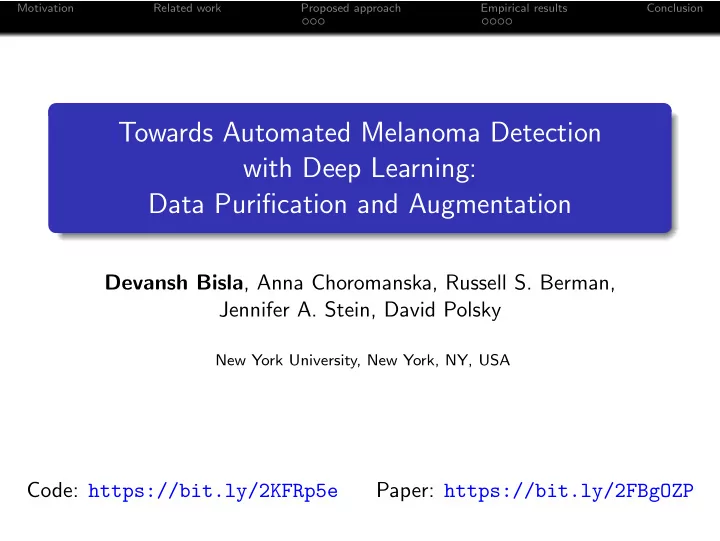

Motivation Related work Proposed approach Empirical results Conclusion Towards Automated Melanoma Detection with Deep Learning: Data Purification and Augmentation Devansh Bisla , Anna Choromanska, Russell S. Berman, Jennifer A. Stein, David Polsky New York University, New York, NY, USA Code: https://bit.ly/2KFRp5e Paper: https://bit.ly/2FBgOZP
Motivation Related work Proposed approach Empirical results Conclusion Motivation Figure 1: (Left) Data Imbalancedness (Right) Data Impurities
Motivation Related work Proposed approach Empirical results Conclusion Existing computational techniques Traditional machine learning Hand-crafted extraction of features from the data such as Lesion Symmetry/Asymmetry. Irregular borders. Non-Uniform pigmentation. Lesion size. Problem: not scalable to large data sets. Deep Learning Automatically extract features from large sized data. Problem: Needs large, balanced, and unbiased data .
Motivation Related work Proposed approach Empirical results Conclusion Traditional training Visualization results for the conventionally-trained model (Top) : Original image. (Bottom) : Visualization mask overlaid on the original image. The model overfits to image occlusions such as hairs, rulers and ink marks.
Motivation Related work Proposed approach Empirical results Conclusion Proposed approach Data Impurities: Removal of unwanted objects such as hair, rulers etc. Data Imbalancedness Synthetic data generation. Data augmentation.
Motivation Related work Proposed approach Empirical results Conclusion Data purification Thresholding in the LUV color space combined with morphological operations. Note that this may also remove dark regions belonging to the lesion itself.[Philippe Schmid-Saugeon et al] Overlay the processed image with the segmented lesion obtained from our segmentation algorithm.
Motivation Related work Proposed approach Empirical results Conclusion Data purification - results (a) (b) (c) (d) (e) Figure 2: Top : Original images. Bottom : Images obtained after a,b) scales, c) hairs and scales, and d,e) hairs removal.
Motivation Related work Proposed approach Empirical results Conclusion Data generation Figure 3: Architecture of Generative Adversarial Network Main idea: Train a generator network to generate images which have similar distribution to the one followed by the training data, but do not appear in the training data set. The discriminator provides a feedback on similarity between the two distributions. We generated 350 images of melanoma and 750 images of seborrheic keratosis.
Motivation Related work Proposed approach Empirical results Conclusion Data generation - results Histogram for Seborrheic Keratosis Histogram for Melanoma 70 60 60 50 50 Frequency 40 Frequency 40 30 30 20 20 10 10 0 0 0.02 0.04 0.06 0.08 0.10 0.0 0.1 0.2 0.3 Mean Squared Error Mean Squared Error Figure 4: Histograms of the MSE values for ( left ) seborrheic keratosis and ( right ) melanoma.
Motivation Related work Proposed approach Empirical results Conclusion Data generation - results Seborrheic Keratosis Melanoma 0.02 0.04 0.059 0.02 0.09 0.18
Motivation Related work Proposed approach Empirical results Conclusion Classification results: confusion matrix Confusion matrix Confusion matrix 80 19 18 83 23 11 M M True label True label 89 269 35 38 338 17 N N 6 15 69 12 6 72 SK SK M N K M N K S S Predicted label Predicted label Figure 5: Confusion matrix obtained by traditional baseline ( left ) and proposed model ( right ).
Motivation Related work Proposed approach Empirical results Conclusion Classification results: ROC-AUC Mean Value ROC-AUC Our Approach 0.915 Kazuhisa Matsunaga[K. Matsunaga et al.] 0.911 RECOD Titans[A. Menegola et al.] 0.908 Table 1: Leader-board for melanoma and seborrheic keratosis combined. Method 82% 89% 95% Top AVG[K. Matsunaga et al.] 0.729 0.588 0.366 Top SK [I. Gonzalez Diaz et al.] 0.727 0.555 0.404 Top M [A. Menegola et al.] 0.747 0.590 0.395 Our Approach 0.697 0.648 0.492 Table 2: Specificity values at sensitivity levels of 82% / 89% / 95% for melanoma classification. Top AVG, Top SK, and Top M denote the winning approaches of the ISIC 2017 challenge.
Motivation Related work Proposed approach Empirical results Conclusion Classification results visualized TP FP FN TN Figure 6: Visualization results for seborrheic keratosis. Top : Original image. Bottom : Visualization result.
Motivation Related work Proposed approach Empirical results Conclusion Classification results visualized TP FP FN TN Figure 7: Visualization results for Nevus. Top : Original image. Bottom : Visualization result.
Motivation Related work Proposed approach Empirical results Conclusion Conclusion Deep learning based methods are the most accurate and scalable, but they require large , pure and balanced training data sets. We presented solutions to improve effectiveness of classification systems by data purification ( removal of unwanted objects ) and data augmentation ( synthetic data generation ).
Recommend
More recommend